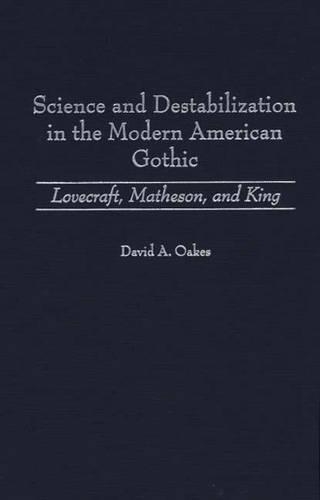
Science and Destabilization in the Modern American Gothic: Lovecraft, Matheson, and King
(Hardback)
Publishing Details
Science and Destabilization in the Modern American Gothic: Lovecraft, Matheson, and King
By (Author) David Oakes
Bloomsbury Publishing PLC
Praeger Publishers Inc
30th June 2000
United States
Classifications
Tertiary Education
Non Fiction
Literary studies: c 1900 to c 2000
813.0872909
Physical Properties
Hardback
160
Description
Shows how 20th-century Gothic fiction has used science and technology as its primary sources of destabilization and, in doing so, has mirrored the development of these areas over the past century. The writers of Gothic literature reflect in their works the concerns and fears of the times in which they were created. These fears, in turn, destabilize the reader; that is, they create within the reader a sense of uneasiness characteristic of the Gothic genre, an uneasiness that comes from the challenging of social and cultural conventions or cherished beliefs. In doing so, these works are also cultural artifacts, for they reflect issues central to society at a given point in time. This book examines the process of destabilization in the modern American Gothic. The volume focuses on the works of three popular 20th-century Gothic writers: H.P. Lovecraft, Richard Matheson, and Stephen King. It argues that science and technology are central to the destabilization process in works by these authors, and it demonstrates how, as cultural artifacts, their writings reflect the fears and concerns of contemporary society. Thus the volume demonstrates how the works of these authors remain within the Gothic literary tradition, while they simultaneously adapt that tradition for a modern audience.
Reviews
[C]lear and accessible style....This volume will be particularly useful to undergraduates and faculty in the study of US popular culture.-Choice
Broderick actively extends the boundaries of science fication critical theory. It's risk well worth taking, and Transrealist Fiction should be read by anyone interested in closely reasoned, cutting-edge criticism.-SFRA Review
Oake's thought-poking conclusion raises a number of issues that may, at the very least, provide the basis for further inquiry into the complex relationships among science, technology, and the Gothic tradition.-Science Fiction Studies
This is a very impressive effort. Oak's academic style is poignant, giving the reader salient points to ponder without the muddled phraseology that often marks works of scholarship.-Readings
Through his carefully detailed analysis of specific texts, Oaks provides a wealth of information to prove his point. His choice of Lovecraft, Matheson, and King demonstrates not only three dramatically differing styles, but three phases in the development in the twentieth-century Gothic tale. Lovecraft represents the beginning third of the century, Matheson, its middle, and King rounds out the end. Oaks also utilizes excerpts from key works to highlight his discussions. This is a very impressive effort. Oak's academic style is poignant, giving the reader salient points to ponder without the muddled phraseology that often marks works of scholarship.-Extrapolation
"Clear and accessible style....This volume will be particularly useful to undergraduates and faculty in the study of US popular culture."-Choice
"[C]lear and accessible style....This volume will be particularly useful to undergraduates and faculty in the study of US popular culture."-Choice
"Broderick actively extends the boundaries of science fication critical theory. It's risk well worth taking, and Transrealist Fiction should be read by anyone interested in closely reasoned, cutting-edge criticism."-SFRA Review
"Oake's thought-poking conclusion raises a number of issues that may, at the very least, provide the basis for further inquiry into the complex relationships among science, technology, and the Gothic tradition."-Science Fiction Studies
"This is a very impressive effort. Oak's academic style is poignant, giving the reader salient points to ponder without the muddled phraseology that often marks works of scholarship."-Readings
"Through his carefully detailed analysis of specific texts, Oaks provides a wealth of information to prove his point. His choice of Lovecraft, Matheson, and King demonstrates not only three dramatically differing styles, but three phases in the development in the twentieth-century Gothic tale. Lovecraft represents the beginning third of the century, Matheson, its middle, and King rounds out the end. Oaks also utilizes excerpts from key works to highlight his discussions. This is a very impressive effort. Oak's academic style is poignant, giving the reader salient points to ponder without the muddled phraseology that often marks works of scholarship."-Extrapolation
Author Bio
David A. Oakes is Instructor of English at South Texas Community College and has previously published in such journals as Lovecraft Studies, Studies in Weird Fiction, and Extrapolation.
